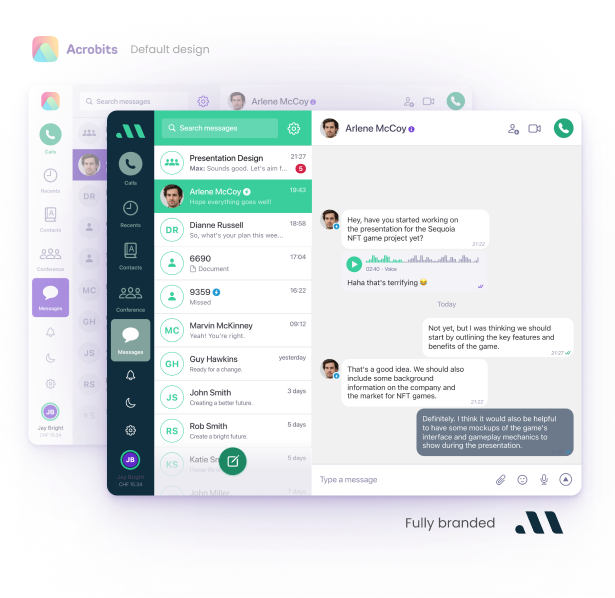
Build a white label softphone app
Create a custom white-label softphone with Cloud Softphone.
- No devs needed
- Native desktop apps
- 100+ premium features

Developing unified communications solutions is more complex than it’s ever been. You not only need to decide which platforms to support but also how you want to deploy.
It isn’t as simple as just developing and deploying in the cloud — not if you want the software to support more complex functionality.
Here’s how Acrobits solved that problem with Cloud Softphone and built a solution that makes it easier than ever to design, build, and deploy a complete business collaboration suite — one that blends the benefits of native software with that of a web-based app.
Before we go too in-depth about our development philosophy, let’s take a quick moment to discuss the difference between the three major types of software.
Native applications are built specifically for a platform or device, usually leveraging the development tools associated with that device’s operating system. Because each major operating system is built using a completely different platform or codebase, native development can be quite challenging if you want to support multiple platforms. You may end up having to code not only for both Android and iOS but also for desktop operating systems such as Windows and MacOS.
Web applications are generally held up as a solution to the challenges of native application development. Rather than being downloaded, web apps are remotely accessed and stored. This allows them to generally be both device- and platform-agnostic.
The main drawback of web apps is that they’re generally unable to access device-specific functionality. This means that, in many cases, a web app might be locked out of some of an operating system’s best and most useful features. In the case of communications software, this also means a lack of support for many headsets — and an inability to support feature-rich SDKs.
There’s also another elephant in the room where web-based communication apps are concerned — their reliance on WebRTC.

As an open standard, WebRTC offers nothing in the way of guaranteed quality of service. It’s also completely reliant on the Internet, with voice communications being severely impacted by connectivity issues. While WebRTC does encrypt all video, audio, and data, this encryption is not strong enough to support regulatory compliance in high-security industries such as healthcare.
Communications software deployed as a web app has no choice but to rely on WebRTC.
Native apps, meanwhile, can use SIP to power voice communications. This enables both greater flexibility and lower latency. Not only that, SIP communications tend to be less impacted by connectivity problems than WebRTC.
The biggest draw of SIP technology, however, is that it allows businesses to continue leveraging their investments into legacy communications hardware. This means you can keep using your desk phones even as you begin exploring more sophisticated UCaaS features. Again, this is only possible through native apps — web apps cannot support SIP.

Create a custom white-label softphone with Cloud Softphone.
At Acrobits, we’ve always prided ourselves on being at the forefront of innovation while efficiently supporting the needs of every client, no matter how complex. We have to ensure our software is available across multiple devices, with simultaneous updates on all platforms. And we have to ensure that our clients can do the same.
A global software company specializing in cross-platform software development, Qt provides a range of powerful development and quality assurance solutions. In our case, the Qt Framework and Development Tools allow us to easily develop native software for multiple operating systems using the same codebase.
It gets better, too. By combining Qt’s functionality with our own expertise, we’ve made it possible for clients to design, build, provision, and deploy enterprise-grade UCaaS apps in less than 24 hours. With Qt native development, Cloud Softphone is also able to support a range of features — arguably the most notable being SDK support for headsets.
Web apps have plenty of benefits. And there are still scenarios where developing a web app is a better option than building a native app. But UCaaS isn’t one of those scenarios.
At the end of the day, you can’t build a good UCaaS platform solely on the web. In order to truly provide the communication and collaboration functionality businesses require, you need to write native code.
And with Acrobits, doing so is as simple as a few clicks. But don’t just take our word for it. Book a demo today, and we’ll show you what you can do.

2024 was a big year for the telecom sector. This year’s shaping up to be even bigger. From artificial intelligence and regulatory challenges to Wi-Fi 7 and 6G, here are seven ways we expect the telecom industry to evolve in 2025. 1. AI Shapes Both Present and Future Unsurprisingly, artificial intelligence remains both the most […]

There’s no denying AI is making inroads in almost every part of business. But what happens when it comes to customer service? AI is transforming how businesses interact with their customers by automating repetitive tasks, analyzing data in real-time, and enabling personalized experiences at scale. From chatbots that resolve issues instantly to predictive algorithms that […]

Within an organization, teams and departments typically develop their own bonds and their own ways of communicating. But what happens when people from various business functions are brought together for a specific project? There are many advantages to cross-functional teams, which combine skills and resources to move projects forward and solve problems creatively. But the […]

TLDR: As MaX UC reaches it’s end-of-life, providers must decide between brand control, simplicity, or cost savings. Options include: Microsoft Teams for stability Cloud Softphone for flexibility and independence Or a reseller path for low-cost operations Each path comes with unique trade-offs in branding, customization, and long-term growth potential. Choose based on your priorities: fast […]